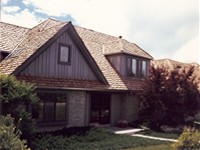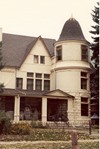Ice Damming
Ice forming along the eaves occurs frequently here along
the Colorado
Front Range including the
Denver Metro Area as well as in many other
areas of the Country. Where there is snow accumulating on the roof and
temperatures falling below freezing for a period of time, there generally is ice
damming along the eaves. If there are ice cycles there is roof ice damming.
The snow on the roof melts slowly, usually from a combination of heat loss from the house through the underside of the roof decking and from the heat of the sun. Small amounts of water start running down and over the surface of the roof until it reaches the eaves where it is much colder and freezes. The ice that forms at the eaves is a minor problem itself. The major problem is what it creates - the ice becomes a dam holding water.
As water continuously runs down the roof it starts ponding or standing behind this ice dam before it also forms more ice and enlarges the ice dam. This slushy mixture of ice and water before it freezes is the cause of many roof leaks because sloped roofing materials are designed to shed water, not hold water. So the water seeps through the roofing materials and starts soaking the roof decking.
Once the water reaches the decking it starts to rot the decking. Water intrusion will find its way through nail holes and joints in the decking into the soffit areas and sometimes into both exterior and interior walls, even into ceilings and floors.
Did you know we have minor ice damming almost every year? We have had major ice damming many other years in the past. When you have snow on the ground (and on roofs) for long periods of time you have major ice damming. Some years maybe only an inch or two but other years 3" to 6" and more. Just a few days with a few inches of snow on the roofs can cause major Ice Dams when the conditions are right - some melting of the snow during the day and freezing temperatures during the night as an example. NOAA's National Weather Service lists ten years here in Denver, Colorado where snow was on the ground anywhere from 27 days in January 1989 through February 1989 up to 63 days in November 1983 through January 1984. Five of the other record breaking years were in the 1970's, 1980's, 1990's, and 2007 had 61 days. So seven of the ten record breaking years for Denver's consecutive days of snow cover were in the not so distant past. (See Click on Tab titled Consecutive Days of Snow Depth on the following National Weather Service webpage.) https://www.weather.gov/bou/DenverFallWinterStatistics
Did you know that some City and County Building Departments have not recognized that we have ice damming? One reason many Building Departments have not been aware of the problem is Building Permits are rarely ever taken out to repair the damage caused by ice dams.
Many Roofing Contractors also mistakenly believe we don't have ice damming problems here along the Front Range. Many Roofing Contractors leave the existing underlayments in place when replacing a roof and never look at the roof decking at the eaves unless their foot falls through it because it has rotted.
Many Building Departments have now changed because of the new wording that first appeared in both the 2006 IBC and IRC and has been continued in the following years editions of the IRC and IBC including the 2021 Edition, which reads; "In areas where there has been a history of ice forming along the eaves causing a backup of water.... an ice barrier shall be installed....". Basically, all sloped roofing materials should be installed over an Ice and Water Membrane not only at the eaves, but in valleys and along walls or chimneys and skylights. The keywords are "history" and "ice forming along the eaves". As indicated by the National Weather Service information listed above, we have major snow cover forming ice along eaves frequently. This occurs more frequently than other building design criteria such as maximum snow loads per square foot and 1 hour rainfall.
Many Roofing Contractors bid and install roofs only to code, never letting the roofing consumer know that there are many roofing guidelines that can be implemented to greatly reduce the chance of roof leaks and other roofing problems not to mention callbacks and litigation. (See Roofing Guidelines Examples web page.) Just because a City/County does not require a particular roofing guideline does not make them right.
When a problem does occur fingers start pointing. "I roofed it to the Local Building Code." "It's not my problem." Just following the Local Building Code has gotten many Roofing Contractors into trouble in the past resulting in litigation where the courts have ruled against them.
Solution
The solution to preventing damage from ice damming at the eaves is very simple. Install an Ice and Water Membrane on the decking at all eaves and up the roof slope 2 feet past the exterior wall for all sloped roofs. Yes, it adds a little more cost to the installation of a new roof but it reduces the risk of having roof leaks due to ice damming to almost zero. Installing heat tape at the eaves helps somewhat but as you can see from some photo below ice will still form even with the use of heat tape.
The Property Owner and/or Board of directors could Opt Out of this guideline: if not required by their Local Building Department or the Manufacturer of the roof covering the Property Owners and/or Board of Directors are using, as long as the Property Owners and/or Board of Directors understand that there is an increased risk of damage to the structure from moisture getting into the structure due to Ice Damming that may not be covered by the Property Owners and/or Board of Directors Insurance Company.
We highly recommend the use of an Ice and Water Membrane at all Eaves, Valleys, Roof to Wall Intersections, Chimneys, and Skylights.
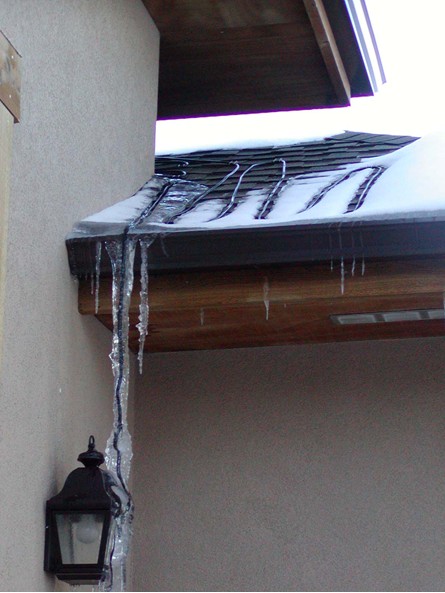
The damage I have seen over the years caused by ice damming ranges from minor water damage to the fascia, which can easily be repainted, to major damage where in one case the soffits, walls, ceilings, and floors had to be replaced to the tune of more than $20,000.00.
Insurance companies do not sort property damage from winter storms into separate categories such as damage from ice damming, roofs collapsing due to snow load, snow blowing in air vents, etc. They do acknowledge that over the years they have received many claims for damage caused by ice damming. Most insurance companies do not pay for the damage caused by Ice Damming unless the roof was also damaged. The cost of repairs usually falls on the property owner.
If your Building Department has not yet
adopted this change requiring an ice and water barrier at the eaves,
it may be up to you, the property owners and contractors, to let your Building
Department
and City Council know that there is a problem with ice damming.
The following are photos I took of ice damming that occurred in the Aurora and Littleton, Colorado areas during the winter of 2007. Some of the photos are of roof slopes facing east and west and of course north. The last three photos are of roofs where the snow and ice was shoveled off to mitigate the damage being caused by ice damming. The same type photos could have been taken in any city along the entire Colorado Front Range during January and February 2007.
If you have any photos and/or stories you would like to share about damage to property caused by ice damming please send an e-mail to solutions@roofkey.com.
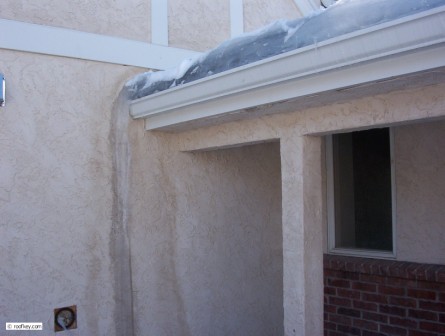
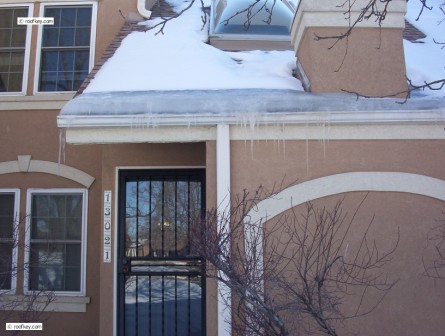
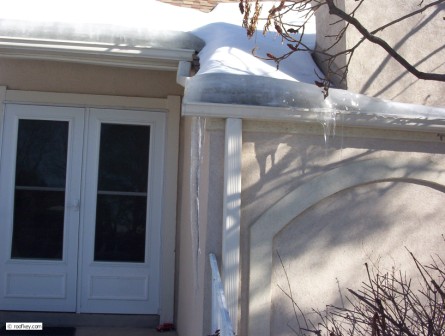
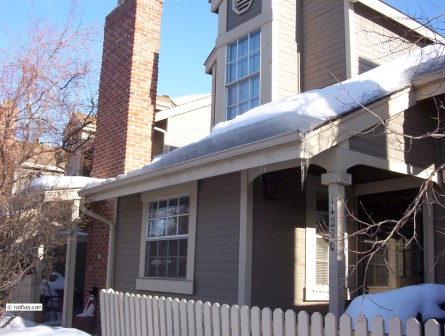
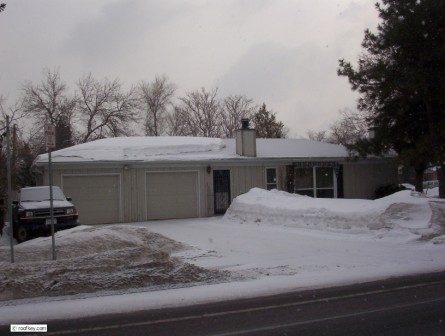
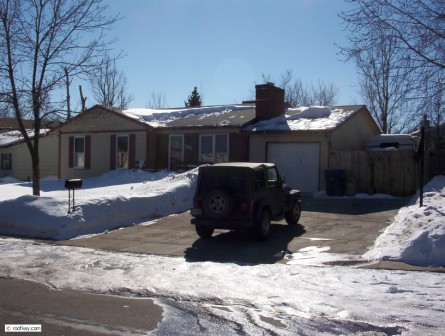
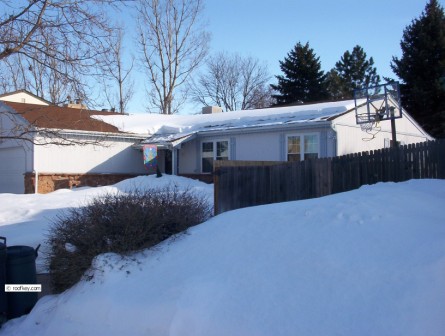
Visit our
Roof Inspection Services
web page
and the many other web
pages throughout this website to find
answers to your roofing questions and
solutions to your roofing problems.
Page Revised/Updated 2/27/2023

